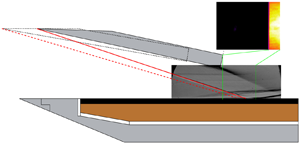Article contents
Hypersonic shock impingement on a heated flat plate at Mach 7 flight enthalpy
Published online by Cambridge University Press: 07 December 2020
Abstract

Elevated wall temperatures and impinging shock interactions are prevalent features in hypersonic flight. Currently, there is a lack of literature regarding experimental studies examining both features in a flight-representative environment. This work details hot-wall, hypersonic, impinging shock/boundary-layer interaction experiments performed in the T4 Stalker Tube. The model configuration was a two-dimensional heated flat plate and a shock generator. The surface of the graphite flat plate was resistively heated to a mean temperature from  $T_w=298\ \textrm {K}$ to
$T_w=298\ \textrm {K}$ to  $T_w\approx 675\ \textrm {K}$ during an experimental run. An oblique shock, generated by a plate that was inclined at
$T_w\approx 675\ \textrm {K}$ during an experimental run. An oblique shock, generated by a plate that was inclined at  $10^{\circ }$ or
$10^{\circ }$ or  $12^{\circ }$ to the free stream, was impinged on the heated flat plate to induce boundary layer separation. The primary flow condition produced Mach 7 flight-equivalent nozzle-supply enthalpy with a unit Reynolds number of
$12^{\circ }$ to the free stream, was impinged on the heated flat plate to induce boundary layer separation. The primary flow condition produced Mach 7 flight-equivalent nozzle-supply enthalpy with a unit Reynolds number of  $4.93\times 10^6\ \textrm {m}^{-1}$. More flow conditions with lower unit Reynolds numbers and flow enthalpies were considered to examine flow separation characteristics. Schlieren and infrared thermography captured the flow field and the wall temperature distribution, respectively. The results showed that the size of the flow separation grew with a higher
$4.93\times 10^6\ \textrm {m}^{-1}$. More flow conditions with lower unit Reynolds numbers and flow enthalpies were considered to examine flow separation characteristics. Schlieren and infrared thermography captured the flow field and the wall temperature distribution, respectively. The results showed that the size of the flow separation grew with a higher  $T_w$ and a lower unit Reynolds number. Moreover, the scaled separation of the present data showed a high discrepancy with existing separation correlations developed from a supersonic impinging shock and a hypersonic compression ramp, mainly due to the higher shock strength. Instead, the present data followed a scaling law that includes the pressure ratio across the impinging shock with a slight dependence on the wall temperature ratio.
$T_w$ and a lower unit Reynolds number. Moreover, the scaled separation of the present data showed a high discrepancy with existing separation correlations developed from a supersonic impinging shock and a hypersonic compression ramp, mainly due to the higher shock strength. Instead, the present data followed a scaling law that includes the pressure ratio across the impinging shock with a slight dependence on the wall temperature ratio.
- Type
- JFM Rapids
- Information
- Copyright
- © The Author(s), 2020. Published by Cambridge University Press
References
REFERENCES
- 17
- Cited by



